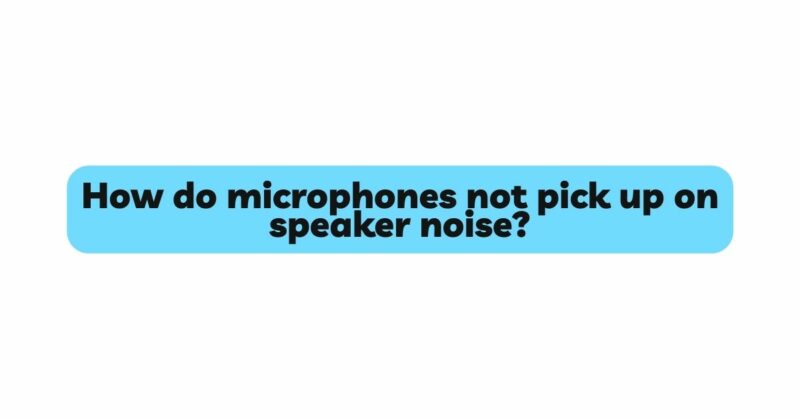In the world of audio technology, achieving pristine sound quality is a paramount goal for effective communication, recording, and content creation. A common challenge faced by many individuals is preventing microphones from picking up speaker noise, which can lead to undesirable feedback, distortions, and compromised audio clarity. In this article, we will delve into the intricate techniques and technologies employed to ensure microphones do not pick up on speaker noise, unraveling the science behind this phenomenon and providing a comprehensive guide on how to achieve seamless audio interactions that maintain the utmost sound fidelity.
I. The Interplay of Microphones and Speaker Noise
- Understanding Speaker Noise: Speaker noise refers to the audio output generated by speakers. When not properly managed, this noise can interfere with microphone recordings, leading to degraded audio quality.
- The Need for Noise Isolation: In various scenarios, such as live performances, studio recordings, and video conferencing, the prevention of microphone pickup of speaker noise is crucial for maintaining clear sound.
II. Microphone Directionality and Polar Patterns
- Polar Pattern Characteristics: Microphones are designed with different polar patterns, which determine their sensitivity to sound from various directions. Certain patterns are better suited to reject sounds from specific angles.
- Cardioid and Supercardioid Patterns: Cardioid and supercardioid microphones have directional sensitivity, allowing them to capture sound mainly from the front and reject noise from the sides and rear.
III. Microphone Placement and Positioning
- Strategic Mic Placement: Position microphones in a way that minimizes their exposure to speaker noise. Placing microphones closer to the sound source and farther from the speakers can significantly reduce unwanted noise pickup.
- Use of Shock Mounts and Isolation: Utilize shock mounts and isolation tools to physically decouple microphones from surfaces that can transmit vibrations and noise, enhancing isolation from speaker-generated noise.
IV. Acoustic Treatments and Sound Isolation
- Acoustic Panels and Bass Traps: Install acoustic panels and bass traps in recording spaces to absorb and diffuse sound waves, minimizing reflections and preventing microphone pickup of reverberations.
- Vocal Booths and Isolation Shields: Vocal booths and isolation shields create a controlled environment for recording, effectively blocking out external noise, including speaker-generated noise.
V. Utilizing Headphones and In-Ear Monitors
- Headphone Monitoring: Encourage the use of headphones or in-ear monitors for performers and speakers. This allows them to hear their audio without the need for loudspeakers, reducing the chance of microphone pickup.
VI. Real-Time Monitoring and Mixing Solutions
- Digital Audio Workstations (DAWs): Utilize DAWs to monitor and mix audio in real time. This allows for precise control over audio levels and helps prevent unwanted speaker noise from being captured.
- Noise Gate and Noise Suppression Plugins: Employ noise gate and noise suppression plugins in your audio processing chain to dynamically cut off audio when it falls below a certain threshold, eliminating unwanted noise.
VII. Acoustic Echo Cancellation (AEC) Technology
- AEC in Communication Systems: AEC technology is used in teleconferencing systems to cancel out any sound from speakers that might be picked up by microphones, ensuring a clear audio feed to participants.
VIII. Advanced Soundproofing Techniques
- Soundproofing Materials: Utilize soundproofing materials such as mass-loaded vinyl, acoustic foam, and soundproof curtains to create an acoustically controlled environment that minimizes external noise.
IX. Manufacturer Solutions and Technology Advancements
- Directional Array Microphones: Directional array microphones utilize multiple microphones to create a beamforming effect, focusing on the desired sound source while rejecting ambient noise.
- Digital Signal Processing (DSP): DSP technology is employed in some microphones to intelligently filter out unwanted noise and enhance the clarity of the captured audio.
X. Conclusion: Achieving Sonic Elegance
The quest to prevent microphones from picking up speaker noise is a pursuit rooted in science, technology, and meticulous planning. By understanding the characteristics of microphone polar patterns, optimizing placement, employing acoustic treatments, and utilizing advanced technologies like AEC and DSP, individuals can achieve sonic elegance in their audio interactions. With an array of tools and techniques at their disposal, whether for live performances, recording sessions, or virtual communication, users can ensure that their microphones capture the desired sound while seamlessly rejecting speaker-generated noise, ultimately delivering an audio experience of unparalleled clarity and quality.


